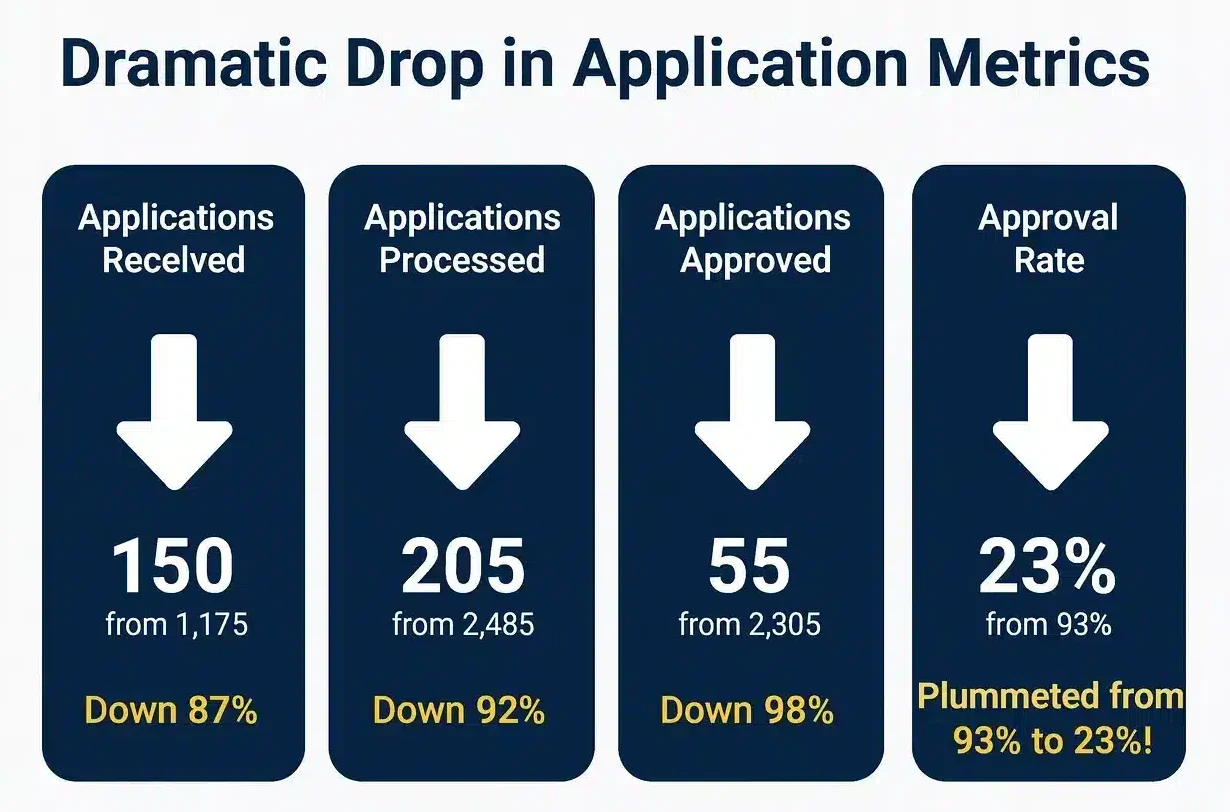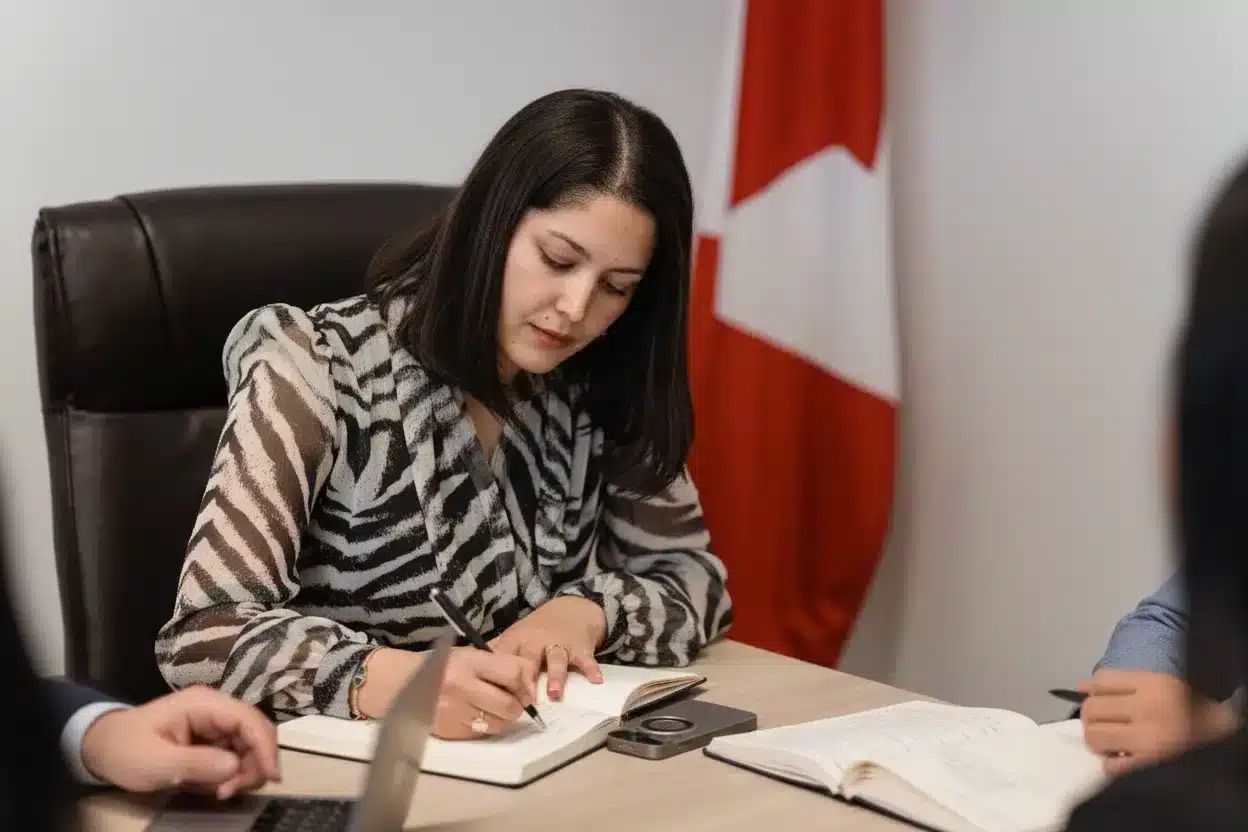Home » News & Insights » A Theory on SUV Plummeting Approval Rates: Are Low Approval Rates Masking the Real Story?
The Puzzling Statistics

The Start-up Visa program’s 2025 statistics present a troubling picture that has sent shockwaves through the immigration community. Comparing January-April 2024 to the same period in 2025 reveals dramatic changes:
- Applications Received: Down 87% (from 1,175 to 150)
- Applications Processed: Down 92% (from 2,485 to 205)
- Applications Approved: Down 98% (from 2,305 to 55)
- Approval Rate: Plummeted from 93% to 23%
At first glance, these numbers suggest a program in complete collapse. The conventional interpretation would be that IRCC has dramatically tightened standards, that application quality has deteriorated, or that the SUV program is being systematically dismantled. However, I believe there may be a more nuanced explanation for these statistics.
A Theory: Strategic Processing Rather Than Program Failure
Based on my analysis of the data patterns and understanding of IRCC’s operational constraints, I propose an alternative theory. These statistics may reflect fundamental changes in processing methodology rather than actual program deterioration.
Hypothesis 1: The Intake System Has Been Restructured
The 87% reduction in applications “received” may not reflect actual market demand. I suggest that IRCC has potentially altered its intake and triaging system, possibly holding applications in a pre-processing queue until certain conditions are met. Applications may no longer be formally acknowledged as “received” until all group members submit their materials and comprehensive completeness checks are finalized for all essential documents.
Critical Evidence Supporting This Theory: SUV Work Permit applications provide a crucial data point that challenges the narrative of collapsed market demand. During the same January-April period, SUV Work Permit applications received dropped only 27% (from 695 to 505), not the same dramatic 87% decline seen in PR applications.
This is significant because applicants become eligible for SUV work permits only after they submit their SUV PR applications and all group members apply for permanent residence. If market demand had truly collapsed by 87%, we would expect to see a corresponding decline in the SUV work permit applications. The fact that work permit applications dropped by only 27% suggests the real decline in SUV interest is closer to that figure, not the 87% shown in PR application statistics.
This discrepancy strongly supports the theory that IRCC has fundamentally changed how it counts “applications received” for PR processing. This has created an artificial bottleneck that dramatically reduces the pool of applications showing up in official statistics, while maintaining a hidden inventory of cases awaiting formal processing.
Hypothesis 2: “Easy Refusals First” Processing Strategy
The most compelling aspect of this theory relates to the 92% reduction in processed applications. IRCC processed only 8% of its typical inventory this year, but I propose this isn’t a capacity issue – it’s a strategic choice about processing sequence.
My theory suggests IRCC has adopted a triage approach where clearly deficient applications – including these older, potentially abandoned cases – are processed and refused quickly, while complex applications requiring careful assessment are held in inventory and processed accordingly. This would create a selection bias where the applications being “processed” are disproportionately those with obvious grounds for refusal, either due to inherent deficiencies or circumstances that have changed over the extended processing period.
In addition, the IRCC has announced that it will prioritize applications received prior to April 2024 to reduce backlog, as well as applications from priority organizations. This means IRCC is arguably now processing applications from 2-3 years ago that have been stuck in the system. These older applications present unique challenges: many applicants may have given up on their SUV applications after years of waiting, making them easier targets for refusal due to changed circumstances, expired supporting documents, or applicant abandonment.
Hypothesis 3: Complex Approvals Are Being Held in Reserve
Under this theory, applications that would typically be approved – those requiring detailed business plan assessments, background checks, and security clearances – are being maintained in extended review cycles. These complex cases, which historically drove higher approval rates, are systematically excluded from current processing statistics.
This would mean that approved applications are being deliberately delayed while refusals are expedited, creating artificially depressed approval rates that don’t reflect the true viability of the applicant pool.
Testing the Theory: What This Would Mean
If this theory is correct, several predictions follow:
- The 23% approval rate is misleading – it represents approval among a subset of applications chosen for processing, not the overall success rate for all applicants.
- Processing times for approvals will be significantly longer – complex cases are being held for extended review rather than processed chronologically.
- Overall approval rates will be higher than current statistics suggest – but won’t be apparent until IRCC works through its complete inventory.
- Strong applications may experience longer delays – not because they’re problematic, but because they require the careful review that IRCC has deprioritized.
Implications If the Theory Is Correct
This processing methodology would represent a significant departure from historical patterns in which applications were handled more uniformly. Instead, we may be seeing the emergence of a two-track system: fast-track refusals for obviously deficient cases and extended review for complex applications requiring nuanced assessment.
The Limitations of This Theory
I acknowledge this remains speculative. The theory assumes IRCC has implemented systematic changes to processing methodology without public announcement. Alternative explanations – including genuine program deterioration, policy changes, or simple resource constraints – remain plausible.
However, the dramatic nature of the statistical changes, combined with the specific patterns observed, suggests that something more systematic than random variation or gradual policy shifts may be occurring.
Conclusion
The true test of this theory will emerge over time: if ultimate approval rates for the current applicant cohort prove higher than the 23% figure suggests, it would support the hypothesis that we’re seeing statistical artifacts rather than program failure. Until then, this remains an informed theory attempting to explain puzzling data patterns in Canada’s flagship business immigration program.
Disclaimer and Invitation for Discussion
Important Notice: This article’s analysis and theories represent my personal observations as a lawyer practicing business immigration and opinions based on publicly available IRCC statistics. These hypotheses are speculative interpretations of data patterns and should not be considered definitive explanations of IRCC’s processing methodologies or policies.
Raw Data for Independent Analysis: I encourage readers to examine the underlying statistics independently and draw their own conclusions. The IRCC statistics can be downloaded at this link.
Alternative Theories Are Welcome: If you have alternative explanations for these statistical patterns, I welcome discussing them. The immigration community benefits from multiple perspectives on complex data trends, and I recognize that my interpretation may be incomplete or incorrect. Please feel free to email us at wecare@sobirovs23dev.wpenginepowered.com or comment on social media.
The purpose of this analysis is to encourage deeper thinking about what approval rate statistics represent, rather than to provide definitive answers about IRCC’s operations. Readers should consider this perspective alongside other analyses and their own professional experience when forming opinions about current SUV program trends.
About the Author
Feruza Djamalova is a licensed Canadian immigration lawyer at Sobirovs Law Firm, a boutique practice dedicated to helping business owners, entrepreneurs, and international students build their future in Canada. Since 2012, she has guided hundreds of clients through complex immigration pathways, including the Alberta Graduate Entrepreneur Stream, Provincial Nominee Programs, and the Start-Up Visa.
Feruza is widely recognized for her clear, practical approach to immigration law. Her insights on business immigration and global talent mobility have been featured in leading publications such as TechCrunch and Forbes . Clients value her transparency, empathy, and strategic advice, which help them navigate the challenges of entrepreneurship and immigration with confidence.
Make Your First Step Towards Canada
Boilerplate Visa Refusals: How to Deal With Them
Introduction Recently, I’ve noticed a troubling pattern in immigration decisions. Both in federal court cases and in my immigration practice, officers are increasingly refusing applications...Our Clients Say…
Posted onTrustindex verifies that the original source of the review is Google. We are incredibly happy and truly grateful to Sobirov Law Firm! They helped my husband receive his work permit through PNP, and they also took care of my work permit visa and the study/visitor visas for our children. This was a very important moment for our family, and the whole team supported us with care, professionalism, and kindness. Every team member was extremely helpful, always answered our questions quickly, and guided us through every step with patience. The lawyers were highly skilled and made the entire process smooth and stress-free. We felt safe and confident throughout the journey because of their amazing work. Thank you so much to the whole Sobirov Law Firm team — we are very happy and appreciate everything you have done for our family. We highly recommend them to everyone!Posted onTrustindex verifies that the original source of the review is Google. I have taken the services of Sobirov Law Firm for my Canadian immigration process, and I must say they have been exceptional, professional, and truly dedicated from the very beginning. My case was quite complicated, yet their team handled it so smoothly, efficiently, and with such a remarkable expertise which was far beyond my expectations. Thanks to their due diligence, guidance, and constant support, I and my family have successfully obtained our Canadian work permits, and we are now keeping our fingers crossed for our Permanent Residency approval. I am deeply grateful to the way they take attention to your details, their transparent communication, and genuine care throughout the process. I strongly believe that Sobirov Law Firm stands out not only for their legal excellence but also for their human approach and commitment to their clients’ success, even if your visa is refused initially, they dedicatedly pursue your case and make sure that a positive outcome is received on your application. I can confidently recommend Sobirov Law Firm to anyone seeking reliable, result-oriented, and professional immigration assistance. I feel if you take their services, you can be confident that your case is in safe, capable, and caring hands. And most importantly, I can't thank enough to Feruza and Judy. Ms. Feruza, my immigration lawyer, and Ms. Judy, her assistant, who have been pivotal in the success of my application. Their expert guidance, prompt communication, and attention to every detail made a complex process feel seamless and well-managed. Deeply indebted to Feruza, Judy and the entire team of Sobirov Law FirmPosted onTrustindex verifies that the original source of the review is Google. Each aspect of the service provided by Sobirovs Law Firm was done with meticulous precision, which made me very satisfied working with this law firm. I am so grateful to have received your service. I truly recommend this firm to anyone in need of professional help with their immigration journey to Canada.Posted onTrustindex verifies that the original source of the review is Google. We would like to express our heartfelt gratitude to Sobirovs Law Firm once again for their outstanding support in renewing our C11 work permit during a particularly challenging period in Canada’s immigration process. A special thank you to Feruza, Madina, and the entire Sobirovs team for their professionalism, patience, and genuine empathy throughout the journey. Their clear guidance, timely communication, and deep understanding of immigration complexities made a stressful process much more manageable. We truly appreciate the dedication and care they showed at every step — it reflected not just expertise, but a sincere commitment to their clients’ success. We would highly recommend Sobirovs Law Firm to anyone seeking trustworthy and compassionate immigration professionals in Canada.Posted onTrustindex verifies that the original source of the review is Google. My wife and I needed guidance with immigrating to Canada. Sobirovs Law Firm was quick to respond, explained our options clearly, and assisted with the required documentation and organization of the documents to make our transition smooth, which it was. The only hiccup in our transition to Canada came with an unscrupulous moving company that attempted to hold all our contents' hostage. In a bit of a panic, I called Sobirovs Law Firm and they paid a visit to the shipping warehouse, confirmed my contents were present, observed a rescaling (saving me $1,500... the trucking company lied about the weight), and acted as an escrow service, to ensure my contents arrived to their final destination prior to releasing funds to the moving company. They went beyond the call of duty for us, I can't thank them enough, and I'm not sure what I would have done without their assistance.Posted onTrustindex verifies that the original source of the review is Google. I highly recommend Sobirovs Law Firm as your business Immigration Lawyer. If you need a Professional Lawyer for expending your business in Canada, Mrs. Feruza and her Team will be your best choice. Thanks very much for your support, Mrs. Feruza and Sobirovs Team.Posted onTrustindex verifies that the original source of the review is Google. I would like to extend my sincere gratitude for your exceptional guidance and dedication throughout my application process. Your professionalism, expertise, and attention to detail made what could have been a stressful experience much smoother and more manageable . I would recommend Sobirovs Law Firm 11 out of 10. They truly care for your best interests. They worked hard and diligently on my case and I’m sure they would for everyone’s case. They are an awesome company and I would use them again if needed and refer them to everyone I know ! Best Regards Ellafi Lajhar LajhargroupPosted onTrustindex verifies that the original source of the review is Google. We had a great experience working with Sobirov law firm. They have experienced lawyers, very diligent and accommodated our quick time frame. It was a pleasure working with them and would highly recommend them.Posted onTrustindex verifies that the original source of the review is Google. I highly recommend Sobirovs for Work Permit for these key reasons: - Professionalism from start to completion - Reasonable fees - Responsive - Great lawyer and support staff I want to send special thanks to Feruza , Vie, Owen, Judy and Madina for working on my work permit. They work hard and to achieve the best outcomes for their clients.Posted onTrustindex verifies that the original source of the review is Google. Dear Sobirovs Law Firm Team, I would like to extend my deepest thanks and appreciation to your entire team for the outstanding support and professionalism you have shown throughout our process. From the beginning, your firm has impressed us with your clear communication, attention to detail, and dedication to providing excellent service. You made a complex and often stressful journey feel smooth and manageable. A very special thank you goes to Feruza Djamalova , vie ,Madina for their exceptional care, guidance, and patience. Your personal involvement, thoughtful responses, and unwavering support made all the difference for us. We truly felt heard, supported, and in the hands of professionals who genuinely care. Thank you once again for everything you’ve done for us. We will always be grateful and would gladly recommend your services to others seeking trustworthy legal guidance in Canada.Verified by TrustindexTrustindex verified badge is the Universal Symbol of Trust. Only the greatest companies can get the verified badge who has a review score above 4.5, based on customer reviews over the past 12 months. Read more












